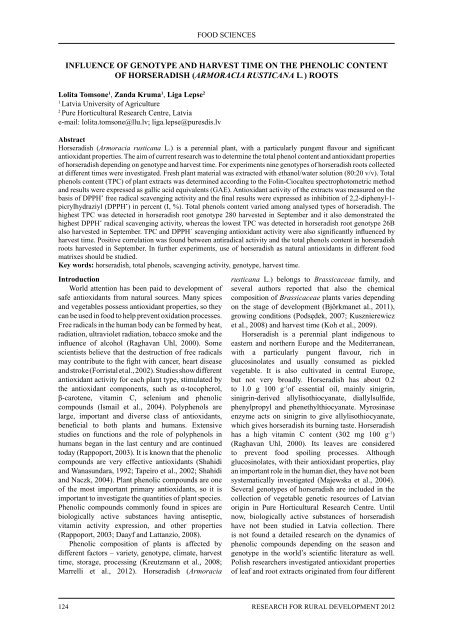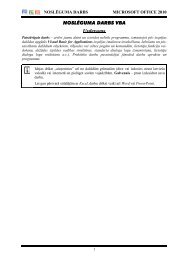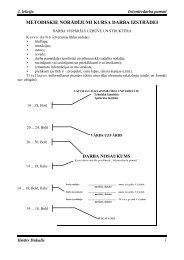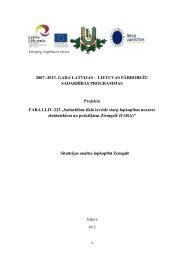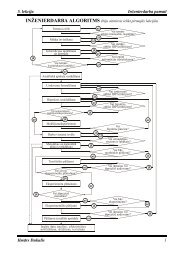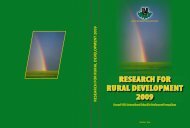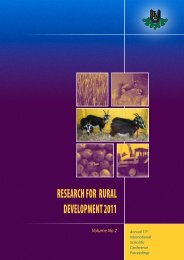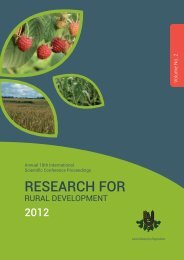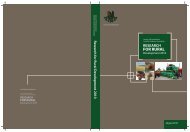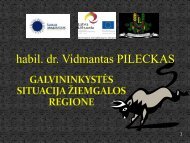LATVIA UNIVERSITY OF AGRICULTURE - Latvijas ...
LATVIA UNIVERSITY OF AGRICULTURE - Latvijas ...
LATVIA UNIVERSITY OF AGRICULTURE - Latvijas ...
- No tags were found...
Create successful ePaper yourself
Turn your PDF publications into a flip-book with our unique Google optimized e-Paper software.
FOOD SCIENCESINFLUENCE <strong>OF</strong> GENOTYPE AND HARVEST TIME ON The PHENOLIC COntentof HORSERADISH (ARMORACIA RUSTICANA L.) ROOTSLolita Tomsone 1 , Zanda Kruma 1 , Liga Lepse 21Latvia University of Agriculture2Pure Horticultural Research Centre, Latviae-mail: lolita.tomsone@llu.lv; liga.lepse@puresdis.lvAbstractHorseradish (Armoracia rusticana L.) is a perennial plant, with a particularly pungent flavour and significantantioxidant properties. The aim of current research was to determine the total phenol content and antioxidant propertiesof horseradish depending on genotype and harvest time. For experiments nine genotypes of horseradish roots collectedat different times were investigated. Fresh plant material was extracted with ethanol/water solution (80:20 v/v). Totalphenols content (TPC) of plant extracts was determined according to the Folin-Ciocalteu spectrophotometric methodand results were expressed as gallic acid equivalents (GAE). Antioxidant activity of the extracts was measured on thebasis of DPPH˙ free radical scavenging activity and the final results were expressed as inhibition of 2,2-diphenyl-1-picrylhydraziyl (DPPH˙) in percent (I, %). Total phenols content varied among analysed types of horseradish. Thehighest TPC was detected in horseradish root genotype 280 harvested in September and it also demonstrated thehighest DPPH˙ radical scavenging activity, whereas the lowest TPC was detected in horseradish root genotype 26Balso harvested in September. TPC and DPPH˙ scavenging antioxidant activity were also significantly influenced byharvest time. Positive correlation was found between antiradical activity and the total phenols content in horseradishroots harvested in September. In further experiments, use of horseradish as natural antioxidants in different foodmatrixes should be studied.Key words: horseradish, total phenols, scavenging activity, genotype, harvest time.IntroductionWorld attention has been paid to development ofsafe antioxidants from natural sources. Many spicesand vegetables possess antioxidant properties, so theycan be used in food to help prevent oxidation processes.Free radicals in the human body can be formed by heat,radiation, ultraviolet radiation, tobacco smoke and theinfluence of alcohol (Raghavan Uhl, 2000). Somescientists believe that the destruction of free radicalsmay contribute to the fight with cancer, heart diseaseand stroke (Forristal et al., 2002). Studies show differentantioxidant activity for each plant type, stimulated bythe antioxidant components, such as α-tocopherol,β-carotene, vitamin C, selenium and phenoliccompounds (Ismail et al., 2004). Polyphenols arelarge, important and diverse class of antioxidants,beneficial to both plants and humans. Extensivestudies on functions and the role of polyphenols inhumans began in the last century and are continuedtoday (Rappoport, 2003). It is known that the phenoliccompounds are very effective antioxidants (Shahidiand Wanasundara, 1992; Tapeiro et al., 2002; Shahidiand Naczk, 2004). Plant phenolic compounds are oneof the most important primary antioxidants, so it isimportant to investigate the quantities of plant species.Phenolic compounds commonly found in spices arebiologically active substances having antiseptic,vitamin activity expression, and other properties(Rappoport, 2003; Daayf and Lattanzio, 2008).Phenolic composition of plants is affected bydifferent factors – variety, genotype, climate, harvesttime, storage, processing (Kreutzmann et al., 2008;Marrelli et al., 2012). Horseradish (Armoraciarusticana L.) belongs to Brassicaceae family, andseveral authors reported that also the chemicalcomposition of Brassicaceae plants varies dependingon the stage of development (Björkmanet al., 2011),growing conditions (Podsędek, 2007; Kusznierewiczet al., 2008) and harvest time (Koh et al., 2009).Horseradish is a perennial plant indigenous toeastern and northern Europe and the Mediterranean,with a particularly pungent flavour, rich inglucosinolates and usually consumed as pickledvegetable. It is also cultivated in central Europe,but not very broadly. Horseradish has about 0.2to 1.0 g 100 g -1 of essential oil, mainly sinigrin,sinigrin-derived allylisothiocyanate, diallylsulfide,phenylpropyl and phenethylthiocyanate. Myrosinaseenzyme acts on sinigrin to give allylisothiocyanate,which gives horseradish its burning taste. Horseradishhas a high vitamin C content (302 mg 100 g -1 )(Raghavan Uhl, 2000). Its leaves are consideredto prevent food spoiling processes. Althoughglucosinolates, with their antioxidant properties, playan important role in the human diet, they have not beensystematically investigated (Majewska et al., 2004).Several genotypes of horseradish are included in thecollection of vegetable genetic resources of Latvianorigin in Pure Horticultural Research Centre. Untilnow, biologically active substances of horseradishhave not been studied in Latvia collection. Thereis not found a detailed research on the dynamics ofphenolic compounds depending on the season andgenotype in the world’s scientific literature as well.Polish researchers investigated antioxidant propertiesof leaf and root extracts originated from four different124 Research for Rural Development 2012


